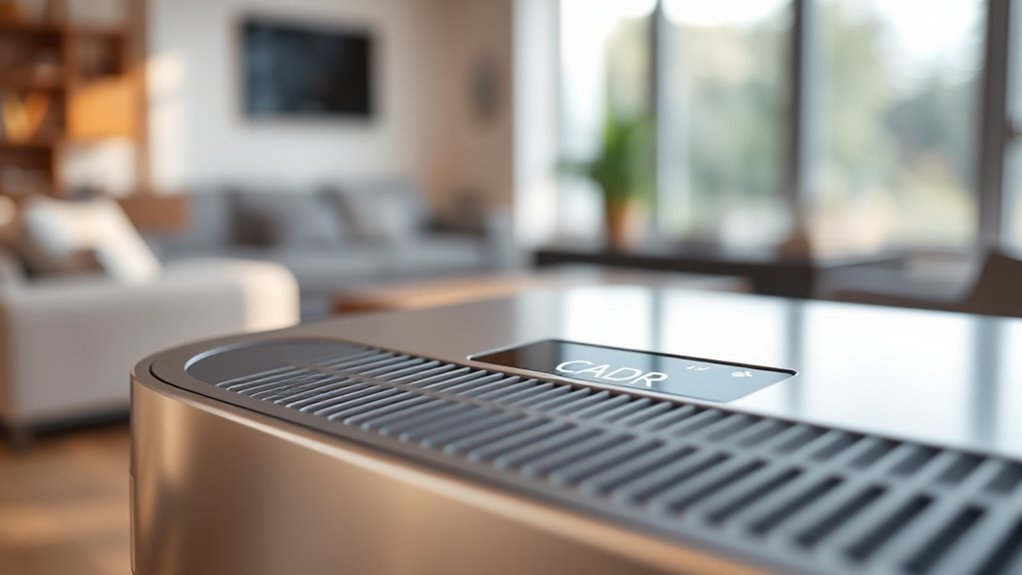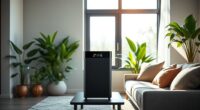A CADR rating shows how effectively your air purifier removes pollutants like dust, smoke, and pollen from the air in your space. It measures the amount of clean air the device delivers, with higher ratings meaning quicker, more efficient purification. Choosing a unit with the right CADR for your room size helps improve air quality and reduces allergens or pollutants faster. Keep exploring to learn how to pick the best purifier for your needs.
Key Takeaways
- CADR (Clean Air Delivery Rate) measures an air purifier’s efficiency in removing specific pollutants.
- Higher CADR ratings indicate faster and more effective air purification in designated room sizes.
- CADR helps consumers select units that match their space and pollutant removal needs.
- Different CADR values for dust, smoke, and pollen show pollutant-specific performance.
- Choosing a purifier with an appropriate CADR ensures better indoor air quality and optimal operation.
Understanding the Basics of CADR
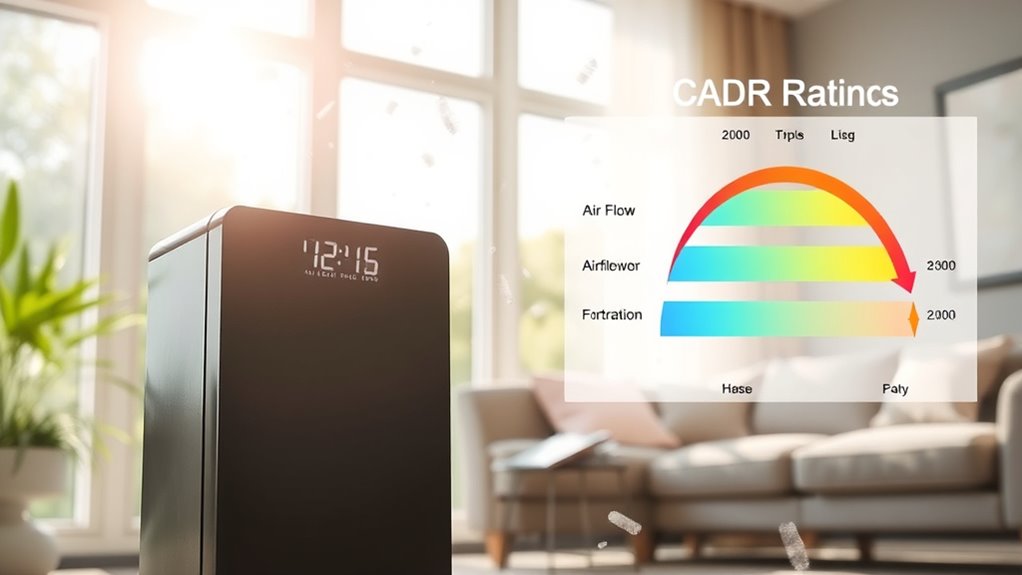
Have you ever wondered how to compare air purifiers effectively? Understanding the basics of CADR helps you do just that. CADR, or Clean Air Delivery Rate, measures a purifier’s ability to improve air quality by removing pollutants like dust, smoke, and pollen. Higher CADR ratings mean the purifier is more efficient at cleaning the air in a specific room size. This directly impacts purifier efficiency, so you can choose a model that suits your space and needs. Remember, a higher CADR indicates faster and more effective air cleaning, which is essential for maintaining healthy indoor air quality. Focusing on air purifier efficiency helps you select the best device for your environment. By focusing on CADR ratings, you ensure your air purifier performs at its best, giving you cleaner, healthier air every day. Additionally, considering other features such as filter types can further optimize your air purification system for specific pollutants. Knowing the coverage area of the device ensures it can handle your room size effectively. To make the most informed choice, evaluating air quality indicators can help you understand your specific indoor environment needs.
How CADR Is Measured and Calculated
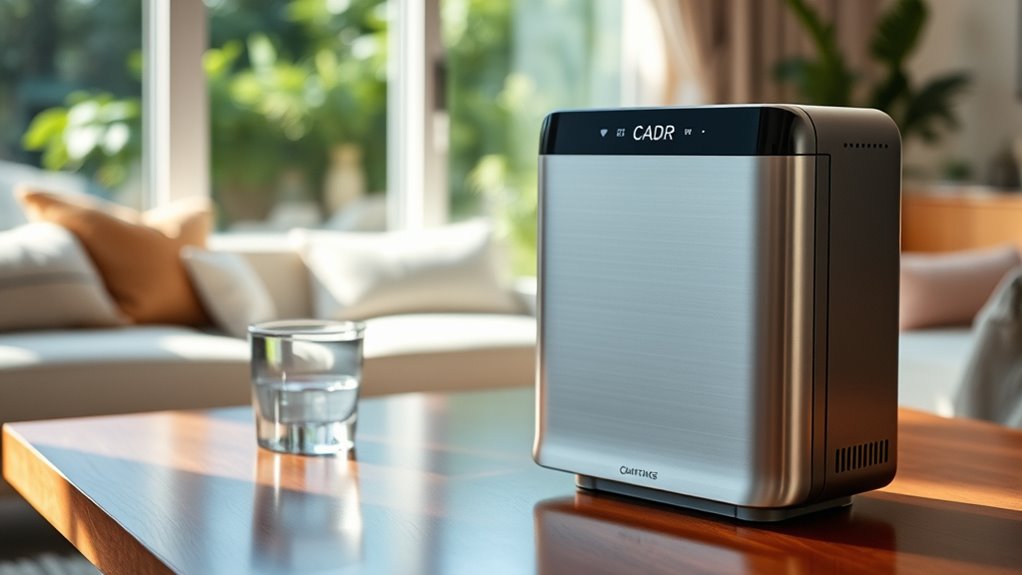
To accurately determine a purifier’s CADR, testing laboratories simulate real-world conditions by measuring how quickly it filters specific pollutants such as dust, smoke, and pollen. They do this through airflow measurement, which assesses how much clean air the device delivers per minute. Alongside airflow, filtration efficiency plays a *vital* role; it indicates how effectively the purifier removes particles from the air. Labs typically run standardized tests, collecting data on particle reduction over a set period. These measurements help calculate the CADR by combining airflow and filtration efficiency, providing a clear picture of the purifier’s performance. The result is a numerical rating that reflects how well the device cleans the air in real-world environments, guiding consumers in selecting effective air purifiers. Additionally, understanding performance upgrades in related Honda models highlights the importance of precise tuning and modifications for optimal results. Moreover, knowing how testing procedures are conducted ensures consumers can rely on CADR ratings for accurate comparisons. It is also beneficial to consider the types of pollutants a purifier is tested against, as this influences the relevance of the CADR rating to your specific needs. A comprehensive understanding of testing standards helps verify the credibility of CADR ratings across different brands and models. Furthermore, awareness of measurement accuracy ensures that consumers can interpret CADR ratings with confidence and make informed decisions.
The Importance of CADR in Air Purifier Selection
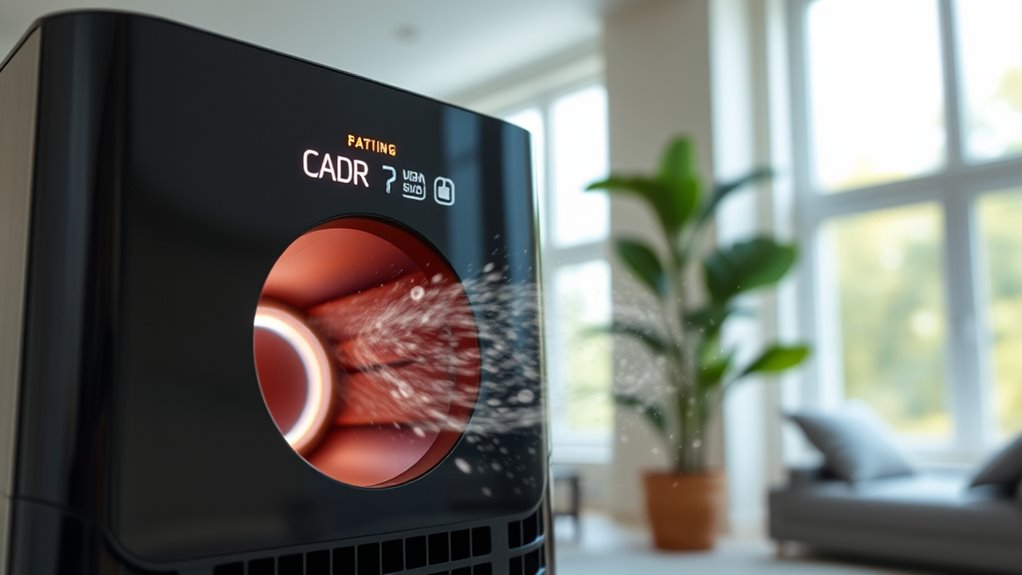
Understanding how CADR is measured helps you recognize its significance when choosing an air purifier. A higher CADR indicates better ability to meet air quality standards and remove pollutants efficiently. It guides you in selecting a unit that matches your room size and pollution levels. Keep these points in mind:
- A CADR aligned with room size ensures effective purification.
- Higher CADR ratings often mean better filter efficiency.
- Meeting air quality standards depends on choosing the right CADR.
- Not all purifiers with high CADR are equally effective; consider filter quality too.
Comparing CADR Ratings for Different Pollutants
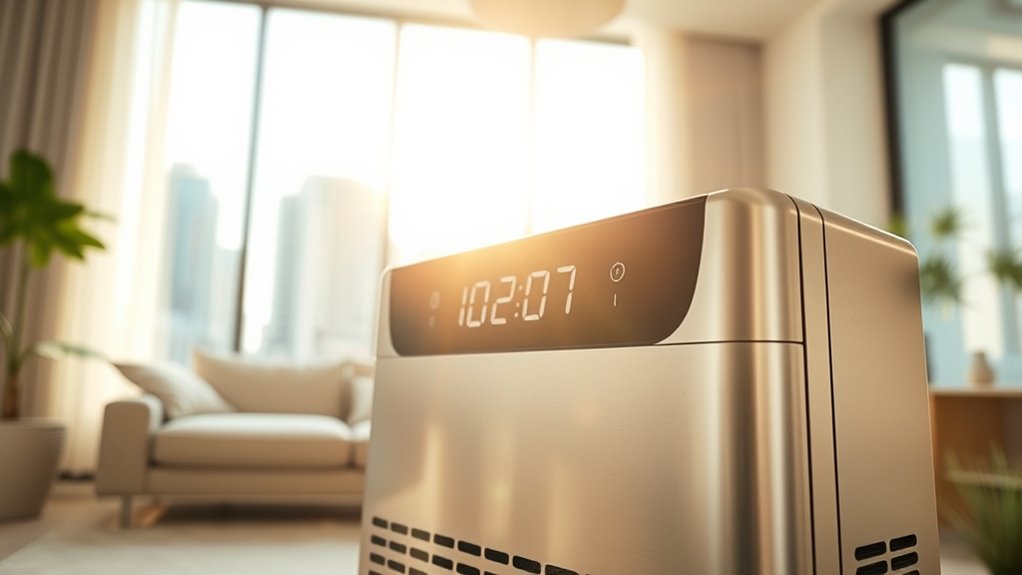
Since different pollutants vary in size and how easily they can be filtered, comparing CADR ratings across these pollutants helps you choose an air purifier that effectively targets your specific concerns. Differentiating pollutants like dust, smoke, and pollen requires understanding how CADR ratings measure precision for each. Higher CADR ratings indicate better filtering performance, but ratings can differ markedly depending on the pollutant type. For example, an air purifier might have a high CADR for dust but a lower one for smoke, reflecting the challenges in filtering smaller particles. Additionally, understanding the filtering efficiency of different devices can help you select the most suitable air purifier for your needs. The particle size plays a crucial role in the effectiveness of air filtration, making it essential to consider when comparing ratings. Recognizing the air purification technology used can also influence your choice, as some methods are more effective against specific pollutants. Advances in filter design have improved the ability of some purifiers to target a wider range of contaminants. Modern advancements in AI-driven drug discovery are transforming how we develop solutions for health concerns, emphasizing the importance of selecting the right technology. Comparing these ratings ensures you select a device suited to your needs. Keep in mind that measuring accuracy can vary, so always check the specific CADR ratings for each pollutant category to make an informed decision.
Tips for Choosing an Air Purifier Based on CADR
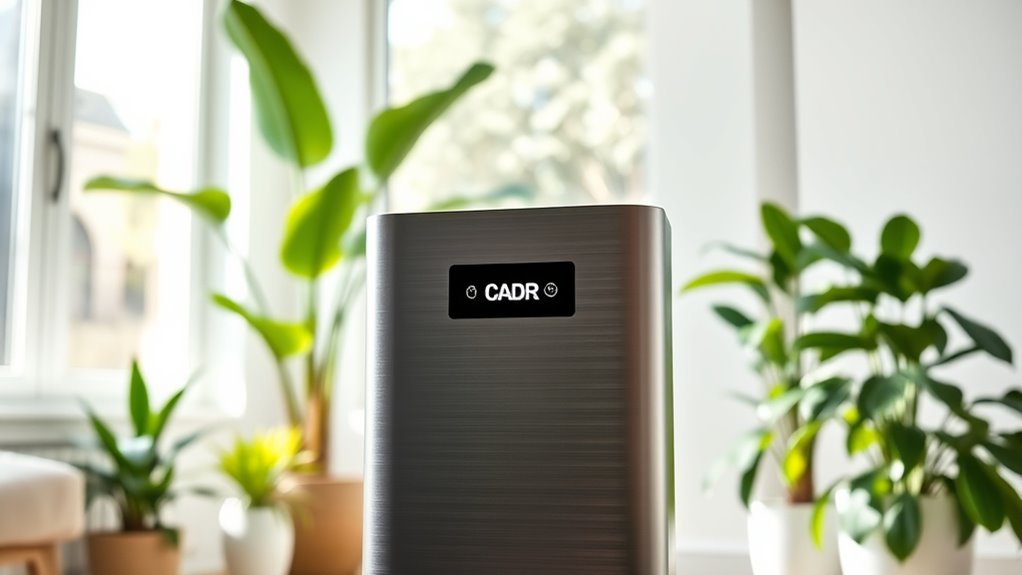
When choosing an air purifier, focusing on the right CADR ratings guarantees you get devices that effectively target your specific air quality concerns. To choose wisely, consider the following tips:
- Match the CADR to your room size for maximum filtration efficiency.
- Prioritize higher CADR ratings for pollutants you’re most concerned about.
- Check that the purifier’s CADR covers all relevant pollutants, like smoke, dust, and pollen.
- Balance CADR with noise levels to ensure your device is effective yet unobtrusive.
- Additionally, understanding 1st Home Theatre Projector can help you select an air purifier that fits well within your space and meets your needs for comfort and performance.
Frequently Asked Questions
How Does CADR Relate to Overall Air Purifier Efficiency?
You want to know how CADR relates to overall air purifier efficiency. CADR measures how quickly an air purifier cleans indoor air of smoke, pollen, and dust, directly impacting indoor air quality. A higher CADR means better air purification performance, so you can rely on it to improve your home’s air cleanliness effectively. Fundamentally, CADR helps you compare air purifiers to find the one that best suits your indoor air quality needs.
Can CADR Ratings Change Over an Air Purifier’s Lifespan?
Imagine your air purifier is a classic car; over time, its performance can change. Cadr ratings can decrease as filters clog or wear out, affecting real-world performance. Regular filter maintenance helps keep the CADR consistent, ensuring your purifier continues to operate efficiently. So, yes, a CADR rating can change over an air purifier’s lifespan, but proper upkeep helps maintain ideal air cleaning and keeps your indoor air fresh.
Is a Higher CADR Always Better for Every Room Size?
You might think a higher CADR is always better, but that’s not necessarily true for every room size. For ideal air circulation, choose an air purifier with a CADR that matches your room’s size. If it’s too high, the purifier may cycle too quickly, wasting energy. Conversely, a lower CADR might not clean the air effectively in larger spaces. So, match the CADR to your room size for best results.
Do Different Brands Use the Same Standards for CADR Testing?
You might think all brands use the same standards for CADR testing, but that’s not always true. Different brands can have variations in testing procedures, affecting how their ratings compare. To make an accurate brand comparison, look for brands that follow standardized testing protocols. Consistent testing guarantees you get a real sense of each air purifier’s performance, helping you choose the best one for your room size and needs.
How Does CADR Account for Air Purifier Noise Levels?
When considering noise impact, CADR ratings don’t directly measure sound levels, but they do help you understand purifier efficiency. Noise can affect your comfort and air quality experience. Look for models that specify sound levels in decibels (dB), and choose ones with lower sound levels for quieter operation. Keep in mind, higher CADR ratings often mean more powerful fans, which can produce more noise, so balance performance with your noise preferences.
Conclusion
Now that you know what CADR ratings mean, it’s clear how they help you pick the right air purifier. When you match the CADR to your space and needs, you’re more likely to enjoy cleaner air and breathe easier. It’s funny how a simple number can make such a difference, isn’t it? So, keep an eye on those ratings—they might just surprise you with how much they improve your indoor environment.
